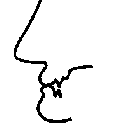
Sounds of English
by Sharon Widmayer and Holly Gray
The nasal sounds

The beginning sounds in "mitt" and "knit", as well as the sound at the end of "bring", are called "nasals". That is because when we makes these sounds, the air goes out of our nose instead of our mouths.
The first sound, /m/, is made by closing your mouth. Now use your voice to make a sound. That is the sound /m/. Try holding your nose and making this sound. You can't do it. You need for the air to go out your nose in order to make this sound.
To the right is a video clip with the /m/ sound. Compare this clip of someone saying 'mom' to the 'pop' clip on the b/p page. Notice how both sounds are made with the lips. BUT when the speaker says 'mom' she doesn't open her mouth again afterwards, but she does when she says 'pop.' Why? For /m/, you only need to close your mouth. For /p/, you need to close your mouth and then open it again to release that puff of air that makes the /p/.

The second sound, /n/, is made by putting the tip of your tongue on the roof of your mouth, right behind your teeth, like you do when you make /d/ or /t/. Now use your voice to make a sound (don't move your tongue!). Be careful that you do not say /l/ instead of /n/. You can check by holding your nose. If you can make the sound and hold your nose, you are saying /l/, if you can't then you are saying /n/.
The nasal sound /m/ in 'mom'
"mitt" sounds:
-
mitt
-
meat
-
mat
-
rum
"knit" sounds:
-
knit
-
neat
-
gnat
-
run
"bring" sounds:
-
bring
-
sang
-
gong
-
rung

The sound at the end of "bring", the "ng" sound is actually one sound even though it is written with two letters. To make this sound, put your tongue up against the roof of the back of your mouth, as if you are going to say /k/ or /g/. Now, make a sound using your voice. This is "ng".
In English, the "ng" sound is only found at the end of syllables. It cannot start a word.